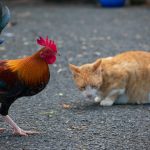Dogs and chickens possess distinct instincts shaped by their evolutionary histories. Dogs, as natural predators, have a strong prey drive that compels them to chase and catch small animals. This instinct is deeply rooted in their genetic makeup and can be difficult to suppress or control.
Chickens, being prey animals, have an innate fear of predators and a powerful instinct to flee from potential threats. Understanding these instincts is essential for creating a safe and harmonious environment for both species. Chickens establish a natural pecking order within their flock, consisting of dominant and submissive individuals.
They exhibit a strong sense of territoriality and will defend their space from intruders, including dogs. Dogs, as pack animals, operate within a strong social hierarchy. They may perceive chickens as potential prey or as intruders in their territory, depending on their individual temperament and training.
Recognizing and respecting these instincts is crucial when introducing dogs and chickens to each other and when designing their living spaces.
Table of Contents
- 1 Creating a Secure Enclosure for Chickens
- 2 Training Your Dog to Respect the Chicken Area
- 3 Providing Adequate Exercise and Mental Stimulation for Your Dog
- 4 Using Positive Reinforcement to Keep Your Dog Away from Chickens
- 5 Supervising Interactions Between Your Dog and Chickens
- 6 Seeking Professional Help if Necessary
- 7 FAQs
- 7.1 What are some effective ways to keep a dog away from chickens?
- 7.2 Why is it important to keep a dog away from chickens?
- 7.3 How can training help keep a dog away from chickens?
- 7.4 What are some signs that a dog may be a threat to chickens?
- 7.5 Are there any products available to help keep dogs away from chickens?
Key Takeaways
- Dogs and chickens have different instincts, so understanding their natural behaviors is important for their coexistence.
- A secure enclosure is essential for keeping chickens safe from potential harm, such as from dogs or other predators.
- Training your dog to respect the chicken area involves positive reinforcement and consistent boundaries.
- Dogs need adequate exercise and mental stimulation to prevent them from becoming overly interested in the chickens.
- Positive reinforcement is key to teaching your dog to stay away from the chickens and to reward good behavior.
Creating a Secure Enclosure for Chickens
Physical Structure of the Enclosure
This enclosure should be sturdy and well-constructed, with a roof to prevent aerial attacks from birds of prey and other predators. The fencing should be buried underground to prevent digging from predators like foxes or raccoons, and it should be tall enough to prevent jumping or climbing over by dogs or other animals.
Providing Shelter and Hiding Spots
In addition to the physical structure of the enclosure, it’s important to provide adequate shelter and hiding spots for the chickens within the enclosure. This can include nesting boxes, roosting bars, and areas of dense vegetation where the chickens can seek refuge if they feel threatened.
Benefits of a Secure Enclosure
Providing a secure enclosure not only protects the chickens from potential harm but also helps to reduce stress and anxiety, which can impact their health and egg production.
Training Your Dog to Respect the Chicken Area
Training your dog to respect the chicken area is essential for creating a safe and harmonious environment for both animals. This training should begin with basic obedience commands, such as “sit,” “stay,” and “leave it,” which can be used to control your dog’s behavior around the chickens. Positive reinforcement techniques, such as treats and praise, can be used to reward your dog for following these commands and for exhibiting calm and non-threatening behavior around the chickens.
It’s important to gradually introduce your dog to the chicken area while on a leash, so you can control their behavior and prevent any potential chasing or aggressive behavior. As your dog becomes more accustomed to the presence of the chickens, you can gradually increase their freedom within the chicken area, always under close supervision. Consistency is key when training your dog to respect the chicken area, and it’s important to be patient and persistent in reinforcing positive behavior.
Providing Adequate Exercise and Mental Stimulation for Your Dog
Providing adequate exercise and mental stimulation for your dog is essential for their overall well-being and can also help to reduce their prey drive and potential interest in chasing or harassing the chickens. Regular walks, playtime, and interactive toys can help to burn off excess energy and provide an outlet for your dog’s natural instincts. Mental stimulation activities, such as puzzle toys or training exercises, can also help to keep your dog engaged and focused on positive behaviors.
Engaging in activities that promote bonding between you and your dog can also help to strengthen your relationship and build trust, which can be beneficial when introducing them to the chickens. A well-exercised and mentally stimulated dog is more likely to exhibit calm and controlled behavior around the chickens, reducing the risk of potential conflicts or accidents.
Using Positive Reinforcement to Keep Your Dog Away from Chickens
Positive reinforcement techniques can be used to teach your dog to stay away from the chickens and to associate their presence with positive experiences. This can include using treats, praise, or toys to reward your dog for staying calm and non-threatening around the chickens. You can also use a cue word or command, such as “leave it” or “back off,” to signal to your dog that they should not approach the chickens.
Consistency is key when using positive reinforcement techniques, and it’s important to always reward your dog for exhibiting the desired behavior around the chickens. It’s also important to avoid using punishment or aversive techniques, as these can create fear or anxiety in your dog and may lead to unpredictable or aggressive behavior.
Supervising Interactions Between Your Dog and Chickens

Why Supervision is Crucial
Even with training and positive reinforcement, it’s essential to always supervise interactions between your dog and chickens. This helps prevent potential conflicts or accidents and allows you to intervene if necessary. Supervision also provides an opportunity to reinforce positive behavior and continue training your dog to respect the chickens.
Remaining Calm and Assertive
When supervising interactions, it’s vital to remain calm and assertive, as dogs can pick up on your emotions and react accordingly. This helps to create a peaceful environment and reduces the likelihood of conflicts.
Preventing Conflicts and Reducing Supervision
It’s crucial to be vigilant and proactive in preventing potential conflicts, such as by redirecting your dog’s attention if they show signs of arousal or interest in the chickens. Over time, as your dog becomes more accustomed to the presence of the chickens, you may be able to gradually reduce supervision, but it’s essential to always be mindful of their interactions.
Seeking Professional Help if Necessary
If you’re struggling to manage the interactions between your dog and chickens, or if you have concerns about their safety, it’s important to seek professional help from a qualified animal behaviorist or trainer. These professionals can provide personalized guidance and support based on your specific situation, as well as help you develop a training plan that addresses any challenges or issues that may arise. Professional help can also be beneficial if you have a particularly challenging or high-energy dog, or if you’re introducing chickens into a household with multiple dogs.
A professional can assess the dynamics between your dogs and chickens and provide tailored advice on how to manage their interactions in a way that promotes safety and harmony for all animals involved. In conclusion, creating a safe and harmonious environment for both dogs and chickens requires an understanding of their instincts and behaviors, as well as proactive management and training. By providing a secure enclosure for the chickens, training your dog to respect their space, providing adequate exercise and mental stimulation for your dog, using positive reinforcement techniques, supervising interactions, and seeking professional help if necessary, you can help to ensure that both animals can coexist peacefully in your home or on your farm.
With patience, consistency, and dedication, it is possible for dogs and chickens to live together in harmony, enriching each other’s lives while respecting their natural instincts.
If you’re looking for tips on how to keep your dog away from your chickens, you may also be interested in learning how to convert a shed into a chicken coop. This article from Poultry Wizard provides valuable information on turning a shed into a safe and secure space for your feathered friends. Check it out here.
FAQs
What are some effective ways to keep a dog away from chickens?
Some effective ways to keep a dog away from chickens include using physical barriers such as fences or chicken wire, training the dog to respect the chickens’ space, and providing the dog with plenty of exercise and mental stimulation to reduce their prey drive.
Why is it important to keep a dog away from chickens?
It is important to keep a dog away from chickens to prevent injury or death to the chickens. Dogs have a natural prey drive and may see chickens as potential targets, leading to potential harm to the chickens.
How can training help keep a dog away from chickens?
Training can help keep a dog away from chickens by teaching the dog to respect boundaries and understand that the chickens are not to be chased or harmed. Positive reinforcement training methods can be used to redirect the dog’s attention away from the chickens.
What are some signs that a dog may be a threat to chickens?
Signs that a dog may be a threat to chickens include chasing, barking, or showing intense interest in the chickens. It is important to monitor the dog’s behavior around the chickens and take steps to prevent any potential harm.
Are there any products available to help keep dogs away from chickens?
There are products available such as motion-activated sprinklers or ultrasonic devices that can help deter dogs from approaching the chicken coop. Additionally, there are also specialized collars and harnesses that can be used to train the dog to stay away from the chickens.
Meet Walter, the feathered-friend fanatic of Florida! Nestled in the sunshine state, Walter struts through life with his feathered companions, clucking his way to happiness. With a coop that’s fancier than a five-star hotel, he’s the Don Juan of the chicken world. When he’s not teaching his hens to do the cha-cha, you’ll find him in a heated debate with his prized rooster, Sir Clucks-a-Lot. Walter’s poultry passion is no yolk; he’s the sunny-side-up guy you never knew you needed in your flock of friends!







